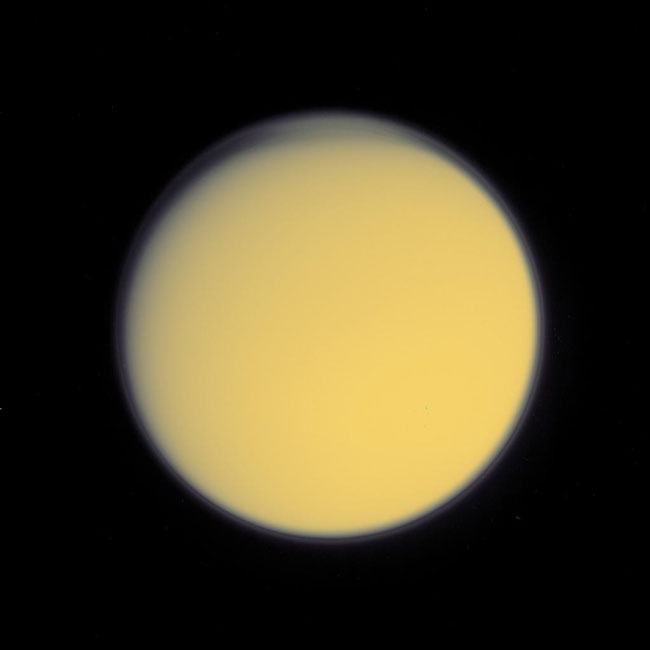Titan: A Good Mystery

When was the last time you read a good mystery novel, or munched popcorn while watching a mystery flick at your local theater? Odds are, either of these entertainments set you back at least $10 and lasted a few hours. For a lesser price, we're all participating in cracking a real mystery--what's beneath the clouds that cover Saturn's moon, Titan?
The Cassini-Huygens Mission launched in 1997, arrived at Saturn, and maneuvered into orbit, July 1, 2004. Cassini will study the Saturn system from orbit for at least 4 years, and Huygens will take a one-way trip to the surface of Titan early in 2005. This orbiter-probe combination is the first human spacecraft to go into orbit about Saturn--all prior missions simply snapped their amazing images of Saturn and its rings and moons as they flew by. None stuck around long enough to delve into the mystery of Titan, the only moon in our solar system shrouded by an atmosphere so dense we can't see through it at visible wavelengths. Simply, Titan looks like a featureless yellowish-orange globe in orbit about Saturn.
What's the mystery here? We haven't yet seen the surface and have only partial understanding of the processes that are occurring there and in Titan's atmosphere. SETI Institute's Dr. Emma Bakes builds computer models of planetary atmospheres to understand how they evolve. She's intrigued. "Titan has long been nominated as a place similar in atmospheric composition to early Earth, before oxygen evolved....Huygens' observations of Titan's haze and its surface features will provide visual and chemical analogs equivalent to a trip in time to an Earth before life began," said Bakes. Unveiling Titan may virtually reveal the early Earth as well.
Cassini-Huygens is a joint project of NASA, the European Space Agency, and the Italian Space Agency. It carries famous names from the early telescopic exploration of Saturn and its moons. In 1609, the Italian scientist, Galileo, first recorded observations of Saturn made through his primitive telescope, and was puzzled by the "cup handles" he saw on either side of the planet. Half a century later, Dutch scientist, Christiaan Huygens, built a better telescope, and solved that mystery: the cup handles were a giant ring that encircled the planet. He also discovered Saturn's largest moon, Titan. Better instruments always advance astronomy, and in 1676, Italian-later French-astronomer, Giovanni Cassini pointed a more powerful telescope at Saturn and discovered a gap in the rings, now named for him, and also found five additional moons. Today, we know of 31 total moons in orbit about Saturn. The Cassini-Huygens Mission is named to honor these early astronomers.
Altogether, the mission is estimated to cost $3.26 billion with the US contribution at $2.6 billion. For each of the 295 million US citizens, that's about equal to the price of a movie ticket and, maybe, a small popcorn. For this modest investment, we get to explore Saturn and its moons over the next several years. I think it's a good deal, and the curtains are just now rising on this mystery show.
Last week, Cassini swooped by Titan and peeked through its hazy atmosphere with radar to make the first surface images we've ever seen of this alien terrain. "Unveiling Titan is like reading a mystery novel," said Dr. Charles Elachi, director of NASA's JPL and leader of the radar instrument team. "Each time you flip the page you learn something new, but you don't know the whole story until you've read the whole book. The story of Titan is unfolding right before our eyes, and what we are seeing in intriguing." So far, Elachi's team has mapped about 1% of Titan's surface, and already there are surprises.
Titan's surface is young. Not many craters are evident. "Titan is a dynamic place with complex geologic processes that may be shaping its surface. Its surface may well be covered with organic materials, but we still don't know how much of the surface is liquid or solid," stated Dr. Jonathan Lunine of the University of Arizona.
Breaking space news, the latest updates on rocket launches, skywatching events and more!
Over the next few weeks, the drama will build. On December 24, the Huygens probe will separate from the Cassini spacecraft, and on January 14, it will descend through Titan's atmosphere to the surface. What will Huygens discover? We have some hints, like any good mystery, from fly-bys of the Pioneer and Voyager Missions as well as other observations, but there is much more to be revealed over the next weeks and months.
The story is just beginning. All this belongs to each of us just for the price of a paperback mystery, or a movie and popcorn.

Edna DeVore is a science and astronomy educator and the former Director of Education and Public Outreach for the SETI Institute. She earned an undergraduate degree from the University of Pacific followed by a master's degree in instructional technology from San Jose State and a master's in astronomy from the University of Arizona. In 1992, Edna joined the SETI Institute, where she wrote features on space exploration, astrobiology and more, some of which appeared on Space.com. She was among the first principal investigators to propose projects to NASA's Office of Space Science and receive funding for educational programs. Edna went on to work on education and public outreach for NASA's Kepler space telescope and SOFIA flying telescope missions. Edna received numerous awards during her tenure at SETI, including NASA Honor Awards for her work on Kepler and SOFIA, and Aerospace Awareness Award for Women in Aerospace in 2005. Edna retired in 2013.
